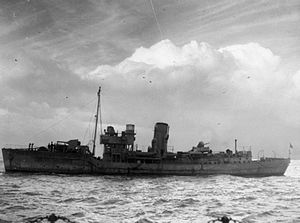HMSPeriwinkle
 HMSPeriwinkle,October 1941
| |
| History | |
|---|---|
| Name | HMSPeriwinkle |
| Namesake | Periwinkle(flower) |
| Builder | Harland & Wolff,Belfast |
| Laid down | 30 October 1939 |
| Launched | 24 February 1940 |
| Commissioned | 8 April 1940 |
| Decommissioned | 15 March 1942 |
| Identification | Pennant number:K55 |
| Fate | Transferred to United States Navy |
| Name | USSRestless |
| Commissioned | 15 March 1942 |
| Decommissioned | 20 August 1945 |
| Identification | Hull number:PG-66 |
| Fate | Returned to Royal Navy |
| Name | HMSPeriwinkle |
| Fate | Sold into civilian service 1947, scrapped 1953 |
| General characteristics[1] | |
| Class and type | Flower-classcorvette |
| Displacement | 925long tons(940 t; 1,036 short tons) |
| Length | 205 ft (62.48 m)o/a |
| Beam | 33 ft 2 in (10.11 m) |
| Draught | 13 ft 7 in (4.14 m) |
| Propulsion |
|
| Speed | 16.5knots(30.6 km/h) |
| Range | 3,500 nautical miles (6,482 km) at 12 knots (22.2 km/h) |
| Complement | 85 |
| Sensors and processing systems |
|
| Armament |
|
HMSPeriwinklewas aFlower-classcorvette,built for theRoyal Navyduring theSecond World War,and was in service in theBattle of the Atlantic. In 1942 she was transferred to theUnited States Navyas part of theReverse Lend-Leasearrangement and renamedUSSRestless,one of theTemptress-class gunboats. With the end of hostilities she was returned to the Royal Navy and sold into mercantile service.
Design and construction[edit]
Periwinklewas built atHarland & Wolff,Belfast,as part of the 1939 War Emergency building programme.[2]She was laid down on 30 October 1939 and launched 24 February 1940. She was completed and entered service on 8 April 1940, being named for theperiwinklefamily of flowers. As built,Periwinklehad the shortforecastlethat was a feature of the early Flowers, and which adversely effected their habitability. She also had the merchant-style enclosed wheelhouse, and the foremast stepped ahead of the bridge, of the original design.
Service history[edit]
[edit]
After working up,Periwinklewas assigned to the Western Approaches Escort Force for service as a convoy escort. In this role she was engaged in all the duties performed by escort ships; protecting convoys, searching for and attacking U-boats which attacked ships in convoy, and rescuing survivors. In 23 months servicePeriwinkleescorted 41 North Atlantic, 10 Gibraltar and 10 South Atlantic convoys[3][4] assisting in the safe passage of over 1500 ships. She was involved in three major convoy battles: In September 1940Periwinklewas part of the escort forSC 2,which was attacked by a U-boat pack, losing 5 ships sunk.[5]In October 1940 she was withHX 77,which lost six ships sunk.[6]On 14 October 1940Periwinkleand the destroyerHMCSSkeenarescued 220 members of the crew ofHMSCheshire,whichU-137had damaged by torpedo.[7]In June 1941Periwinklewas withOB 329,which saw four ships andU-147sunk;Periwinkleshared in the U-boat's sinking.[8][9] In September 1941 she was withHG 73,which lost nine merchant and one warship sunk.[10]
[edit]
Following the entry of the United States into the war the US Navy was in need of anti-submarine warfare vessels, and to meet this need a number of ships were transferred from the Royal Navy as part of a reverse Lend-Lease arrangement.[11] Periwinklewas commissioned into the USN on 15 March 1942 as USSRestless.After an overhaulRestlesswas employed as an escort on convoys betweenNew Yorkand theCaribbean. In August 1945 she was decommissioned and returned to the Royal Navy.[12]
Fate[edit]
Periwinklewas stricken in 1947 and sold into commercial service as the merchant shipPerilock.She was scrapped atHong Kongin 1953.[12][13]
Notes[edit]
- ^Conway p62
- ^Elliott p.187
- ^Periwinkle:convoy movementsat naval-history.net; retrieved 18 July 2020
- ^Periwinkle:convoy assignmentsat convoyweb.org.uk; retrieved 18 July 2020
- ^Blair p.182
- ^Blair p.197
- ^Helgason, Guðmundur."HMS Cheshire (F 18)".Ships hit by U-boats.Retrieved9 January2024.
- ^Blair p.307
- ^Kemp p.70
- ^Blair pp.389-391
- ^Elliott p189
- ^abRestlessat history.navy.mil;retrieved 18 July 2020
- ^Periwinkleat uboat.net; retrieved 18 July 2020
References[edit]
- Blair, Clay(2000).Hitler's U-Boat War: The Hunters 1939–1942.London: Cassell.ISBN0-304-35260-8.
- Chesneau, Roger, ed. (1980).Conway's All the World's Fighting Ships 1922–1946.Greenwich, UK: Conway Maritime Press.ISBN0-85177-146-7.
- Elliott, Peter (1977).Allied Escort Ships of World War II: A complete survey.London: Macdonald and Jane's.ISBN0-356-08401-9.
- Hague, Arnold (2000).The Allied Convoy System 1939–1945.ISBN1-55125-033-0(Canada);ISBN1-86176-147-3(UK)
- Kemp, Paul (1997).U-Boats Destroyed, German submarine losses in the World Wars.Arms and Armour.ISBN1-85409-515-3.
